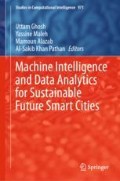Abstract
The mobile-based community participation model is a mobile app for citizens to solve everyday problems. The project involved development of mobile app for smartphones integrated with e-Governance for Nagpur Municipal Corporation in Central India as a part of the Smart Cities initiative. The model is an innovative mobile-based system for a multi number of task involving community participation. It provides effective solutions for reporting civic problems to the local authorities. The application of a similar model can solve urban problems and promote community participation in smart cities. Furthermore, this chapter investigates the question on what is a Smart City? How to develop a mobile app for promoting community participation? How to develop a cloud-based model that could be integrated with the existing system of e-Governance? How smart technology is developed by integration of Geographic Information System (GIS) and Global Positioning System (GPS)? The mobile-based community participation model has many benefits. Because of its benefit, it can be easily applied to smart cities.
Access this chapter
Tax calculation will be finalised at checkout
Purchases are for personal use only
References
Badii, C., Bellini, P., Nesi, P., & Paolucci, M. (2019). A smart city development kit for designing Web and mobile Apps, pp. 1–8.
Jog, Y., Venkatesh, R., Pandit, A., Bhadauria, R. S., & Padmavati. (2017). Understanding role of mobile apps in smart city services. International Journal of u- and e- Service. Science and Technology, 10(4), 27–38.
Farias, R. S., de Souza, R. M., McGregor, J. D., et al. (2019). Designing smart city mobile applications. Empirical Software Engineering, 24, 3255–3289.
Kunttu, I. (2019). Developing smart city services by mobile application, Conference: ISPIM Connects Ottawa—Innovation for local and global impact. Ottawa: Canada.
Almao E. C., Golpayegani F. (2019). Are mobile apps usable and accessible for senior citizens in smart cities?. In J. Zhou, G. Salvendy (eds.) Human Aspects of IT for the Aged Population. Design for the Elderly and Technology Acceptance. HCII 2019. Lecture Notes in Computer Science, Vol. 11592, Springer.
Alessandria, F. (2021). Smart city: The citizen protagonist. In C. Bevilacqua, F. Calabro, L. Della Spina (eds.) New Metropolitan Perspectives. NMP 2020. Smart Innovation, Systems and Technologies, Vol. 178. Springer.
Matarazzo et al. (2018). Crowdsensing framework for monitoring bridge vibrations using moving smartphones. Proceedings of the IEEE, 106(4).
Dlodlo, N., Gcaba, O., & Smith, A. (2016). Internet of things technologies in smart cities. 2016 IST-Africa Week Conference, Durban, pp. 1–7.
Barrile, V., Fotia, A., Bernardo, E., & Bilotta, G. (2021) Geomatic techniques: A smart app for a smart city. In C. Bevilacqua, F. Calabrò, L. Della Spina (eds.), New Metropolitan Perspectives. NMP 2020, Smart Innovation, Systems and Technologies, Vol. 178, Springer.
Harford, T. (2014). Big data: A big mistake? Significance, 11, 14–19.
Guenduez, A. A., Singler, S., Tomczak, T., Schedler, K., & Oberli, M. (2018). Smart government success factors. Swiss Yearbook of Administrative Sciences, 9(1), 96–110.
Prayogo, I., & Ramadhan, R. (2020). Smart city and its application. IOP Conference Series: Materials Science and Engineering, 879.
Akcin, M., Kaygusuz, A., Karabiber, A., Alagoz, S., Alagoz, B., & Keles. C. (2016). Opportunities for energy efficiency in smart cities. 4th International Istanbul Smart Grid Congress and Fair (ICSG), Istanbul, pp. 1–5.
Lee, S., Oh, K., & Jung, S. (2009). The carrying capacity assessment framework for ubiquitous ecological cities in Korea. In 2nd International Urban Design Conference, Gold Coast 2009, Australia.
Gazder, U., Shehabi, A., Fardan, K., Alkhabbaz, H., & Ibrahim, Z. (2019). Smart parking solution for congested areas: Application of vertical rotary systems, 2nd Smart Cities Symposium (SCS 2019), Bahrain, pp. 1–5.
Bhatt, D., & Tiwari, M. (2019). Smart traffic sign boards (STSB) for smart cities, 2nd Smart Cities Symposium (SCS 2019), Bahrain, pp. 1–4.
Muster, S. et al. (2017). How to involve inhabitants in urban design planning by using digital tools? An overview on a state of the art, key challenges and promising approaches. 21st International Conference on Knowledge Based and Intelligent Information and Engineering Systems, KES2017, Procedia Computer Science, vol. 112, pp. 2391–2405.
Stelzlea, B., & Noenniga, J. R. (2017). A database for participation methods in urban development. International Conference on Knowledge Based and Intelligent Information and Engineering Systems, KES2017, 6–8 September 2017, Marseille, France, Procedia Computer Science 112, pp. 2416–2425.
Nelson, N., & Wright, S. (1995). Power and Participatory Development: Theory and Practice (pp. 1–18). Intermediate Technology Publications, London.
van Empel, C. (2008). The effectiveness of community participation in planning and urban development. WIT Transactions on Ecology and the Environment, 117.
Akre, V., & Yankova, V. (2019). Smart city facilitation framework (SCFF) and the case of Dubai smart city. 2019 International Conference on Computational Intelligence and Knowledge Economy (ICCIKE), Dubai, United Arab Emirates, pp. 576–580.
Author information
Authors and Affiliations
Corresponding author
Editor information
Editors and Affiliations
Rights and permissions
Copyright information
© 2021 The Author(s), under exclusive license to Springer Nature Switzerland AG
About this chapter
Cite this chapter
Parlewar, P. (2021). Applying Mobile-Based Community Participation Model in Smart Cities. In: Ghosh, U., Maleh, Y., Alazab, M., Pathan, AS.K. (eds) Machine Intelligence and Data Analytics for Sustainable Future Smart Cities. Studies in Computational Intelligence, vol 971. Springer, Cham. https://doi.org/10.1007/978-3-030-72065-0_6
Download citation
DOI: https://doi.org/10.1007/978-3-030-72065-0_6
Published:
Publisher Name: Springer, Cham
Print ISBN: 978-3-030-72064-3
Online ISBN: 978-3-030-72065-0
eBook Packages: Intelligent Technologies and RoboticsIntelligent Technologies and Robotics (R0)

